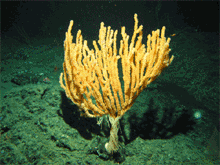
View a slide show of a new species of live bamboo coral, Isidella tentaculum found of the Giacomini Seamount. ![]() Click image to view the slide show.
Click image to view the slide show.
Corals: They Aren't Just for the Tropics Anymore
August 19, 2004
Peter Etnoyer
Sponsored by Marine Conservation Biology Institute
![]() Watch how a snail fish (family Liparidae) was collected with the DSV Alvin’s suction gun. (mp4, 3 MB)
Watch how a snail fish (family Liparidae) was collected with the DSV Alvin’s suction gun. (mp4, 3 MB)
![]() See how a Siphonogorgia sp. coral (family Nidaliidae) was discovered on Pratt Seamount. (mp4, 2.9 MB)
See how a Siphonogorgia sp. coral (family Nidaliidae) was discovered on Pratt Seamount. (mp4, 2.9 MB)
One of our challenges on this research mission is to name the deep-sea corals we bring up from the abyss. Seamount habitats in the Gulf of Alaska are particularly challenging for species identification, because deep-sea corals here are poorly documented. When we dive here, we’re exploring places never before seen by human eyes. Some of the corals are familiar, while others are completely unknown. Yet, with proper background research, some shared expertise, and a few proper images of our seamount discoveries, we can give a name to our collections.
When we talk about deep sea corals in the Gulf of Alaska, we are mostly talking about “octocorals.” Octocorals are close relatives of the large sea fans frequently seen in underwater pictures from clear tropical seas. One of the challenges associated with the study of octocorals is their incredible diversity. Over 2,500 species of octocorals populate the world’s oceans. That’s about twice as many species as we find in the stony, reef building corals on better-known tropical coral reefs worldwide. It’s nearly impossible to know all the octocorals, so scientists depend on each other, well-preserved samples, and good documentation techniques to make it easier to share and compare collections.
Corals are invertebrates, meaning they don’t have backbones, but they do have bones. Deep sea corals have tiny microscopic bones called “sclerites” imbedded in the flesh of their polyps. Sclerites come in many shapes and sizes. They provide support to the fleshy parts of the coral, and they provide clues that help scientists identify the organisms they collect.
Sclerites are not our only clues for differentiating coral species. The polyps are arranged along the branch arms of the coral, much the way leaves are arranged along the branch of a tree. Branching patterns and polyp arrangement are additional characteristics that help describe a species.
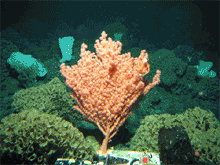
View a slide show of Paragorgia sp., bubblegum coral, collected from Welker Seamount. ![]() Click image to view the slide show.
Click image to view the slide show.
Back in the 1800s and 1900s, skills like drawing and painting were considered essential to any course of study in biology. Many scientists were also great artists, and they produced their own imagery to describe what they saw while out at sea. They would spend hours on deck, painting watercolors of their specimens. We still use some of these images today to reference our collections. In modern science, digital video and still photography provide the imagery we need to share and compare our specimens; photography skills are the modern equivalents of watercolor and illustration skills from centuries past.
One of the tools I am developing for deep-sea coral identification purposes is called “life cycle photography.” This method tracks our submersible collections from the sea floor to the laboratory, photographing the octocoral colony at each step along the way. For each sample, we take a photographic journey from the sea floor to the microscope. It all starts with the DSV Alvin, which has four video cameras and two still cameras specially designed to photo document life in the deep sea. Then, scientists like Amy Baco-Taylor (see Amy’s log from August 16) and myself preserve and photograph the specimens, preparing them for further study.
Once we have proper life cycle documentation, we name the octocorals we collect by comparing them to photographs and illustrations of the original specimen, described in some scientific journal. This original specimen is known as the “holotype.” These “holotypes” are stored in museums such as the Smithsonian Institution National Museum of Natural History. Scientists come from all over the world to compare new collections to old ones in order to determine whether their species is well known, poorly known, new to science, or new to the region. This is the science of systematics, the study of the branches in the Tree of Life.
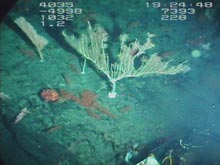
This skeleton of a bamboo coral colony was covered in bryozoans. This specimen was much too big to fit in any of the sample boxes and was brought to the surface locked in the DSV Alvin’s mechanical arm. Click image for larger view.
What Do You Do if You See Bamboo? Practice Good Forestry
Aurélie Shapiro
National Ocean Service
Special Projects Office
You're inside the Alvin submersible and you spy the largest dead bamboo specimen seen on this expedition to date. What do you do? In the words of Alvin pilot Bruce Strickrott: “You don’t leave it down there."
Bamboo corals are octocorals in the family Isididae. They thrive in cold, deep waters. Often they are home to several galatheid crabs (also known as pinch-bugs) at the same time. Principal Investigator Peter Etnoyer, who is in charge of Team Big Bamboo, provides specific instructions on “what to do when you see bamboo.” This methodology for deep-sea bamboo coral collection maximizes the information we can get from a single collection and insures that the samples are shared across disciplines.
Wednesday, August 11, Dive #4035: diving scientists Amy Baco-Taylor and Naomi Ward sighted a large, vibrant colony of bamboo coral in 1,000 m of water on Welker Seamount. A few minutes later, the deep submergence vehicle (DSV) Alvin came upon a dead bamboo skeleton; according to the science observers’ descriptions, these large eerie bone-trees were everywhere. Some of these dead colonies measured nearly 2-in wide at the base, as large as a small tree. But, according to the Team Bamboo credo: one may collect a colony only when others are visible and numerous, and one must never take the largest living specimen. In the words of Chief Scientist Tom Shirley, “We practice good forestry.”
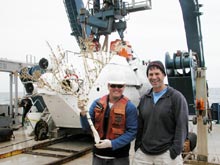
Principal Investigator Peter Etnoyer and DSV Alvin pilot Bruce Strickrott display a large dead bamboo coral skeleton that was successfully collected by the Alvin. Click image for larger view.
Peter was called up to Top Lab, the control room that communicates with the sub during its dives. During the sub’s ascent, Bruce told Peter over the radio that an entire coral skeleton, over 2-ft tall, had been collected using Alvin’s robotic arm. Since it was far too large to fit in any of the collection boxes, Bruce had placed it on the lid of boxes, and then secured it with the arm during Alvin’s rise to the surface.
Previously, we lost a big bamboo coral sample in rough seas during Alvin’s recovery, while the sub bobbed at the surface. The coral "escaped" before it could be hooked, towed in, and lifted onto the R/V Atlantis by the ship’s huge A-frame crane. This time we took special precautions to make sure we brought both the live and dead specimens onboard intact. Peter rode in the Avon, the small boat that races out to meet the sub at the surface. He retrieved the big bamboo and carried it by hand back to the boat. I seized the giant dead specimen from Alvin as soon as it was onboard the Atlantis.
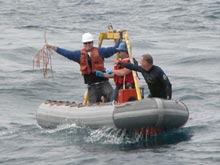
Carl Wood, the ship’s steward/Alvin group swimmer; Ed Popowitz (aka Catfish), the Avon driver; and Principal Investigator Peter Etnoyer, Team Bamboo, holding a fragile live specimen retrieved from the Alvin right after it surfaced. Click image for larger view.
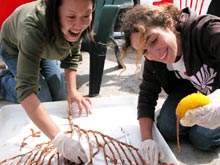
Shinobu Okano (left) and Aurélie Shapiro apparently relish the gruesome task of cleaning the tissue and mucus off of a bamboo coral colony. Click image for larger view.
Our team collects bamboo specimens for radiocarbon dating, biomaterials research, chemical analysis, histology, genetic analysis, photography, and microscopy. Once we have the living samples safely preserved for histology and taxonomy, we clean the bamboo skeleton. It is a gruesome, smelly, dirty, gooey process that we must perform outside on the deck, as coral secretes mucus when stressed. As you can imagine, being clawed by an alien ship and lifted a kilometer to the surface can be quite stressful.
From the dead specimen, we removed the bryozoans -- moss-like animals that grow on the dead coral skeleton -- and then sieved to collect any tiny creatures that might have been using the big dead bamboo (or bryozoans themselves) for habitat. Finally, both specimens were clean, and we laid them out to dry. Two of the largest, most intact bamboo coral specimens ever to be collected from the Gulf of Alaska are now prepared to reveal their secrets so that we may better understand the forces that shape these unique deep-sea coral communities.
Sign up for the Ocean Explorer E-mail Update List.
























